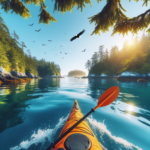Kayaking in Great Smoky Mountains, Tennessee/North Carolina, USA
Introduction to Kayaking
Kayaking is a popular outdoor activity that offers a unique blend of adventure, exercise, and a close connection with nature. Whether you’re navigating through serene lakes, challenging river rapids, or exploring coastal waters, kayaking provides an exhilarating experience that appeals to both beginners and seasoned paddlers. The sport has gained immense popularity over the years, thanks to its accessibility and the sheer joy it brings to those who partake in it.
This article aims to spotlight the unique features of kayaking in the Great Smoky Mountains, located on the border of Tennessee and North Carolina, USA. We’ll explore why this region is a fantastic destination for kayaking enthusiasts, delving into its geography, climate, and the various kayaking spots that make it a must-visit location. By the end of this article, you’ll have a comprehensive understanding of what makes kayaking in the Great Smoky Mountains a unique and thrilling experience.
Kayaking in the Great Smoky Mountains offers a unique blend of natural beauty, diverse wildlife, and challenging water conditions. The region’s rivers and lakes provide a variety of kayaking experiences, from tranquil paddles to adrenaline-pumping rapids. Whether you’re a novice looking for a peaceful outing or an experienced kayaker seeking a challenge, the Great Smoky Mountains have something to offer.
What sets kayaking in the Great Smoky Mountains apart is its unique combination of stunning landscapes, rich biodiversity, and historical significance. The area is not just a kayaking destination but a place where you can immerse yourself in the natural and cultural heritage of the region. So, grab your paddle and get ready to explore one of the most captivating kayaking destinations in the USA.
Overview of Kayaking in Great Smoky Mountains, Tennessee/North Carolina, USA
The Great Smoky Mountains, straddling the border between Tennessee and North Carolina, are renowned for their mist-covered peaks, lush forests, and abundant wildlife. The region’s geography is characterized by its rugged terrain, numerous rivers, and pristine lakes, making it an ideal location for kayaking. The climate varies with elevation, offering a range of conditions from temperate lowlands to cooler highlands, which can influence your kayaking experience.
Historically, the waterways of the Great Smoky Mountains have been vital for transportation and sustenance for the indigenous peoples and early settlers. Today, these same waterways offer recreational opportunities for kayaking enthusiasts. The cultural ties to water sports are evident in the local communities, where kayaking and canoeing are celebrated activities.
Accessing the Great Smoky Mountains for kayaking is relatively straightforward. The region is well-connected by road, with several entry points from both Tennessee and North Carolina. Popular access points include Gatlinburg and Townsend in Tennessee, and Cherokee and Bryson City in North Carolina. These towns offer amenities and services that cater to outdoor enthusiasts, making it easy to plan your kayaking adventure.
The best times to visit for kayaking are during the spring and fall when the weather is mild, and the water levels are ideal. Spring brings blooming wildflowers and vibrant greenery, while fall offers stunning foliage and cooler temperatures. However, summer is also a popular time, especially for those looking to combine kayaking with other outdoor activities like hiking and camping.
Kayaking Conditions in Great Smoky Mountains, Tennessee/North Carolina, USA
The Great Smoky Mountains offer a variety of water conditions suitable for different types of kayaking. The region is home to several rivers, including the Little River, Pigeon River, and Nantahala River, each offering unique kayaking experiences. Additionally, there are numerous lakes such as Fontana Lake and Douglas Lake, which provide calmer waters for a more relaxed paddling experience.
The weather conditions in the Great Smoky Mountains can vary significantly throughout the year. Spring and fall are generally mild, with temperatures ranging from the 50s to 70s Fahrenheit, making these seasons ideal for kayaking. Summer temperatures can reach the 80s and 90s, which is perfect for water activities but can also bring afternoon thunderstorms. Winter is less popular for kayaking due to colder temperatures and potential snowfall.
Water currents and tides are important factors to consider when kayaking in the Great Smoky Mountains. Rivers like the Pigeon and Nantahala offer varying levels of rapids, from Class I to Class IV, providing challenges for different skill levels. It’s essential to check the water flow and current conditions before heading out, as these can change rapidly due to rainfall and other environmental factors.
Environmental factors such as water temperature, wildlife activity, and vegetation can also impact your kayaking experience. For instance, spring and early summer are great times to observe wildlife like river otters, beavers, and various bird species. However, it’s crucial to be aware of your surroundings and practice eco-friendly kayaking to minimize your impact on the natural habitat.
Top Spots for Kayaking in Great Smoky Mountains, Tennessee/North Carolina, USA
The Great Smoky Mountains offer several top spots for kayaking, each with its unique features and challenges. One of the most popular locations is the Little River, which flows through the heart of the national park. This river offers a mix of calm sections and moderate rapids, making it suitable for both beginners and experienced kayakers. The scenic beauty of the surrounding forest and the chance to spot wildlife add to the appeal.
Another excellent spot is the Pigeon River, known for its thrilling rapids and stunning scenery. The Upper Pigeon River section is famous for its Class III and IV rapids, providing an adrenaline-pumping experience for advanced kayakers. In contrast, the Lower Pigeon River offers gentler waters, making it ideal for families and beginners. The best time to kayak here is during the summer when water levels are higher due to dam releases.
Fontana Lake is a must-visit for those who prefer a more tranquil kayaking experience. This expansive lake, surrounded by the Smoky Mountains, offers calm waters perfect for leisurely paddling. The lake’s clear waters and picturesque shoreline make it a great spot for fishing and swimming as well. Early morning or late afternoon are the best times to kayak here to avoid the midday heat and enjoy the serene atmosphere.
For a unique kayaking experience, consider exploring the Nantahala River. This river is renowned for its crystal-clear waters and challenging rapids, ranging from Class II to III. The Nantahala Outdoor Center offers guided tours and rentals, making it accessible for kayakers of all skill levels. The best time to visit is during the spring and summer when water levels are optimal, and the surrounding forest is lush and green.
Safety and Regulations
Safety is paramount when kayaking in the Great Smoky Mountains. Local regulations require all kayakers to wear a personal flotation device (PFD) at all times while on the water. It’s also advisable to carry a whistle or other sound-producing device to signal for help if needed. Familiarize yourself with the specific regulations for each river or lake you plan to kayak, as they can vary.
In addition to wearing a PFD, it’s essential to have the right safety gear and equipment. This includes a helmet for those tackling rapids, a first-aid kit, a waterproof map or GPS device, and a dry bag to keep your belongings safe. Always check the weather forecast and water conditions before heading out, and let someone know your planned route and expected return time.
Handling emergency situations while kayaking requires preparation and knowledge. If you capsize, stay calm and try to stay with your kayak if possible. Practice self-rescue techniques and know how to re-enter your kayak from the water. In case of an injury or other emergency, use your whistle to signal for help and try to reach the nearest shore or safe area.
Local authorities and park rangers are valuable resources for safety information and assistance. They can provide updates on water conditions, weather forecasts, and any potential hazards. It’s also a good idea to take a kayaking safety course or join a guided tour if you’re new to the area or the sport. These measures will help ensure a safe and enjoyable kayaking experience in the Great Smoky Mountains.
Amenities and Accommodations
The Great Smoky Mountains region offers a range of amenities to make your kayaking adventure more convenient and enjoyable. Several rental facilities provide kayaks, paddles, and safety gear, making it easy for visitors to get started. Guided tours are also available, offering expert knowledge and a safer experience, especially for beginners or those unfamiliar with the area.
When it comes to accommodations, the region has something for everyone. For those who love the great outdoors, there are numerous camping sites within the national park, offering a chance to immerse yourself in nature. These campsites range from primitive backcountry sites to more developed campgrounds with amenities like restrooms and picnic areas.
If you prefer more comfort, there are plenty of hotels, lodges, and cabins in nearby towns like Gatlinburg, Townsend, Cherokee, and Bryson City. These accommodations offer a range of options from budget-friendly motels to luxurious mountain lodges. Many of these establishments cater specifically to outdoor enthusiasts, providing services like shuttle transportation to popular kayaking spots and storage for your gear.
In addition to kayaking, the Great Smoky Mountains offer a wealth of recreational activities for visitors. Hiking, fishing, and wildlife watching are popular pursuits, with numerous trails and scenic spots to explore. For a change of pace, you can visit local attractions like the Great Smoky Mountains Railroad or the Oconaluftee Indian Village. These activities provide a well-rounded experience, ensuring there’s something for everyone to enjoy.
Environmental Considerations
Preserving the natural habitats and wildlife of the Great Smoky Mountains is crucial for maintaining the area’s beauty and ecological balance. As a kayaker, you play a vital role in this effort by practicing eco-friendly kayaking. This includes minimizing your impact on the environment and respecting local wildlife.
One of the key guidelines for eco-friendly kayaking is to avoid disturbing wildlife. Maintain a safe distance from animals and their habitats, and never feed or attempt to interact with them. Be mindful of your noise levels, as loud sounds can disrupt the natural behavior of wildlife. Additionally, avoid paddling through sensitive areas like nesting sites or shallow waters with aquatic vegetation.
Proper waste disposal is another important aspect of eco-friendly kayaking. Always pack out what you pack in, including food wrappers, bottles, and other trash. Use biodegradable soap if you need to wash anything, and avoid using harmful chemicals that can pollute the water. If you come across litter during your kayaking trip, consider picking it up to help keep the waterways clean.
Supporting local conservation efforts is a great way to contribute to the preservation of the Great Smoky Mountains. Many organizations and projects focus on protecting the area’s natural resources and wildlife. Consider donating to or volunteering with these groups to make a positive impact. By following these guidelines and supporting conservation efforts, you can help ensure that future generations can enjoy the beauty and adventure of kayaking in the Great Smoky Mountains.
Highlights
When comparing kayaking in the Great Smoky Mountains to other popular kayaking destinations, several unique features stand out. The region’s biodiversity is one of its most remarkable aspects, with over 19,000 documented species of plants and animals. This rich biodiversity provides kayakers with the opportunity to observe a wide variety of wildlife, from river otters and beavers to numerous bird species.
The geographical features of the Great Smoky Mountains also set it apart from other kayaking locations. The mist-covered peaks, lush forests, and pristine waterways create a stunning backdrop for any kayaking adventure. The region’s diverse terrain offers a range of kayaking experiences, from tranquil lake paddles to challenging river rapids, catering to all skill levels.
Historically, the Great Smoky Mountains hold significant cultural importance. The waterways were vital for the indigenous peoples and early settlers, and today they continue to play a crucial role in the local communities. This historical significance adds an extra layer of depth to your kayaking experience, allowing you to connect with the region’s rich heritage.
Data-driven analysis shows that the Great Smoky Mountains offer a unique combination of natural beauty, diverse wildlife, and challenging water conditions that are hard to find elsewhere. While other kayaking destinations may excel in specific areas, the Great Smoky Mountains provide a well-rounded experience that appeals to a wide range of kayakers. Whether you’re seeking adventure, relaxation, or a connection with nature, this region has something special to offer.
FAQ Section
- What is the best season to go kayaking in the Great Smoky Mountains? The best seasons are spring and fall due to mild weather and ideal water levels.
- Are there beginner-friendly spots for kayaking? Yes, locations like Fontana Lake and the Lower Pigeon River are suitable for beginners.
- What should I bring for a kayaking trip? Essential items include a personal flotation device (PFD), paddle, helmet (for rapids), first-aid kit, waterproof map or GPS, and a dry bag.
- Are kayak rentals available? Yes, several rental facilities offer kayaks, paddles, and safety gear.
- How can I participate in local conservation efforts? You can donate to or volunteer with local conservation organizations focused on preserving the area’s natural resources and wildlife.
- Are guided kayaking tours available? Yes, guided tours are available and offer expert knowledge and a safer experience, especially for beginners.
- What safety measures are in place? Local regulations require wearing a PFD at all times. It’s also advisable to carry a whistle, first-aid kit, and check weather and water conditions before heading out.
Final Thoughts
Kayaking in the Great Smoky Mountains, Tennessee/North Carolina, USA, is a premier destination for kayaking enthusiasts. The region’s stunning landscapes, diverse wildlife, and challenging water conditions make it a must-visit location for anyone passionate about kayaking. Whether you’re a novice or an experienced paddler, the Great Smoky Mountains offer a variety of experiences that cater to all skill levels.
As you plan your kayaking adventure, remember to respect local guidelines and conservation efforts. Practicing eco-friendly kayaking and supporting local conservation projects will help preserve the natural beauty and ecological balance of the region. By doing so, you contribute to the sustainability of this incredible destination for future generations.
In conclusion, the Great Smoky Mountains provide a unique and thrilling kayaking experience that combines adventure, relaxation, and a deep connection with nature. From tranquil lakes to adrenaline-pumping rapids, this region has something for everyone. So grab your paddle, explore the beauty of the Great Smoky Mountains, and create unforgettable memories on the water.









